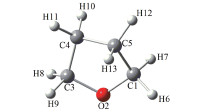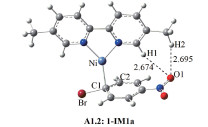On account of the abundant C—H bonds in nature, the direct modification of nonactive C—H bonds to forge complex molecular structures has been vastly investigated in organic synthesis. The selective functionalization of C—H bonds catalyzed by transition metal has emerged as a key strategy in modern organic chemistry. In recent decades, numerous excellent strategies through transition metal catalysis to achieve challenging C—H bond functionalizations have been reported, such as ruthenium[1], rhodium[2-4], palladium[5], copper[6], iron[7] or nickel[8-10] complexes, wherein the directing groups, stoichiometric additives, strong acids or oxidants[11-14] are generally needed, which might be a deficiency of the synthetic methods.
Over the past four decades, visible light photocatalysis has been tremendously employed in water splitting[15-16], CO2 reduction[17], and the exploitation of novel solar cell materials[18]. Nevertheless, until recent years, the application of this catalytic method come to be recognized in organic synthesis[19-20]. In 2007, the Osawa et al.[21] took the lead in applying photocatalysis to the transition metal Pd catalyzed C—C coupling reactions, obtaining significantly increased yield. Later in 2011, Kalyani et al.[22] successfully realized the direct C—H arylation at room temperature by employing the aryldiazonium salts, combining visible-light photoredox catalysis with Pd catalysis.
Inspired by the elegant work of the Osawa and Sanford group, a groundbreaking catalysis platform was emerged at the right moment, termed as metallaphotoredox catalysis, combining photoredox catalysis with transition-metal catalysis. Numerous advances using the metallaphotoredox catalysis were published, exhibiting its unique advantages in C—H functionalization to forge C—C and C—heteroatom bonds[23-25]. Among the plentiful publications, the vast majority of C—H activations were achieved with the utility of precious transition metal catalysts. Concerning the deficiency of these 4 d and 5 d transition metals as being cost-intensive and usually quite toxic[26], the development of powerful strategies relying on earth-abundant and less toxic 3 d transition metal catalysts has been in growing demand. Recent advances have demonstrated a remarkable interest in the exploitation of nickel catalyzed C—H functionalization reactions[27-31]. In terms of publications of recent years, it has to be mentioned that the MacMillan group have developed valuable technologies in the field of direct C(sp3)—H bond alkylation and arylation by using nickel catalyst in conjunction with photoredox catalyst such as Ir[dF(CF3)ppy]2(dtbbpy)PF6[32-34]. However, taking the aforementioned economic factors into consideration, the necessity of probing into novel and alternative photocatalysts for Ir complexes, the widely used species in the photoredox catalysis part, is desirable. Several studies have clarified that carbonyl compounds such as benzaldehyde, acetophenones, quinones and diaryl ketones can be used as efficient photosensitizers and H atom abstractors, in terms of their advantageous photochemical properties as accessible and long-lived triplet states[35-38].
In 2018, Martin and co-workers put forward a dual catalysis platform, combining diaryl ketones for the photoredox catalysis and the nickel catalyst for the transition metal catalysis, which accomplished the sp3 C—H bond arylation and alkylation of tetrahydrofuran(THF) with aryl halides and alkyl halides at room temperature, respectively[39]. They found that sp3 C—H arylation and alkylation occur in the o-hydrogen atom of THF. In addition, a higher yield (95%) of target sp3 C—H arylated product was achieved under the presence of the L ligand (L=5, 5′-dimethyl-2, 2′-bipyridine), while that was 35% under the absence of the L ligand. Furthermore, the yield of sp3 C—H arylated product is only 5% under the absence of Na2CO3. Moreover, for aryl halides containing various substituents, their reactions all can afford good yields.
Martin's work caught our great interest in the following questions: (ⅰ) Why the o-hydrogen atom of THF is functionalized? (ⅱ) What is the active catalyst in the reaction system? (ⅲ) In the nickel catalysis, which one of the two reactants could firstly combine with the nickel catalyst? (ⅳ) How the nickel catalyst is regenerated? (ⅴ) Why the Na2CO3 species is important to the reaction?
To the best of our knowledge, there is no theoretical exploration of the reaction mechanisms reported in the literature. Herein, in order to unveil the above mentioned questions and deeply understand the reaction mechanism, we performed density functional theory (DFT) calculations on several representative reaction systems.
1 Computational methodsAll DFT calculations were carried out with the Gaussian 09 program[40]. Geometry optimization calculations were performed for all the stationary points along the reaction pathways using the B3LYP functional[41-42], with a mixed basis set, SDD[43], for nickel and 6-31G(d, p)[44] for the other atoms (named as BS1). Frequency analysis calculations for all of the stationary points were conducted at the same level as for the geometry optimizations to confirm whether they are local minima (no imaginary frequencies) or transition states (only one imaginary frequency). The intrinsic reaction coordinate (IRC)[45-47] has been calculated to verify whether the obtained transition states are connected with the reactants, intermediates or products. Based on the gas-phase optimized structures, the single-point energies were evaluated using the B3LYP functional with a mixed basis set of SDD for nickel and 6-311+G(d, p)[48] for other atoms (denoted as BS2). In order to obtain the solvation energies, M05-2X[49] functional with solvent model density(SMD)[50-51] in THF solution (used in the experiment[39]) in the self-consistent reaction field (SCRF) was employed, in conjunction with a mixed basis set, SDD for nickel and 6-31 G(d)[44] for other atoms (named as BS3). The enthalpies and free energies in THF solution were obtained from the B3LYP/BS1-calculated frequencies. The B3LYP/BS2 free energies with the M05-2X/BS3 solvent corrections at 298.15 K and 1 atm were used in the following discussion.
2 Results and discussionsHerein, we firstly investigated the detailed reaction mechanisms for the sp3 C—H arylation of THF with 4-trifluoromethyl bromobenzene in subsection 2.1. Then the effect of substitutents in aryl halides on the sp3 C—H arylation reactions were discussed in subsection 2.2, and the detailed mechanisms for sp3 C—H alkylation reactions (see reaction B below) were investigated in subsection 2.3.
2.1 Mechanisms for sp3 C—H arylation reactionsBased on the speculation by Shen et al.[39], the whole reaction from reactants 1 and 2 to product 3 for the sp3 C—H arylation (reaction A1 in Fig. 1) can be divided into three reaction processes: formation of THF· radical (ketone catalysis), generation of the product catalyzed by nickel catalysts (nickel catalysis), and regeneration of the Ni catalyst. For easy understanding, the above three reaction processes are illustrated in Fig. 1a. Herein, we took the C—H arylation of tetrahydrofuran with 4-trifluoromethyl bromobenzene (named as reaction A1.1) as an example and explored the detailed mechanisms for the three reaction processes in turn.

|
Download:
|
|
Fig. 1 The studied sp3 C—H arylation and alkylation reactions |
|
The diaryl ketone was utilized as the photocatalyst to fulfill the catalysis in the experiment[39]. We firstly calculated the energy gap between the excited singlet state and the ground state of the diaryl ketone molecule (ΔES0S1), and the calculated ΔES0S1) value of ketone is 67.5 kcal/mol, which is in excellent agreement with the experimental value of 67.7 kcal/mol. The energy gap between the triplet state and the ground state of ketone (ΔES0T1) is also calculated and the ΔES0T1 value is predicted to be 60.3 kcal/mol, which is only 7.4 kcal/mol lower than that of ΔES0S1. In order to determine whether the triplet ketone has reactivities to proceed the hydrogen atom transfer (HAT) with THF, leading to the formation of THF·, we calculated the HAT process between them. It has to be mentioned that in the optimized THF structure, all the C—H bonds in the ortho position (named as o-C—H bonds) are longer than those in the meta position (named as m-C—H bonds), indicating that the o-C—H bonds are weaker than m-C—H bonds (Table S1). This implies that the o-C—H bonds may be more easily functionalized. Furthermore, the formation of both the ortho-positioned THF· radical (o-THF·) and meta-positioned THF· radical (m-THF·) were calculated and the results are shown in Fig. 2. Along the reaction pathway of the o-THF· formation, the ortho-positioned H atom in the THF molecule cooperates with Int1 (the triplet ketone) to form an intermediate IM1 and the reaction free energy for this step is 7.0 kcal/mol. Subsequently, IM1 converts to another intermediate IM2 via a transition state TS1 with a free energy barrier of 5.4 kcal/mol, releasing the free energy of 9.4 kcal/mol. It is the occurrence of the latter reaction step that makes the reaction to proceed smoothly. Notably, the O1—H1 and H1—C1 bond lengths in IM1 are predicted to be 2.824 and 1.094 Å(1 Å=0.1 nm), respectively, while those in IM2 become to be 0.983 and 2.107 Å. These facts indicate that the O1—H1 bond is formed and the C1—H1 bond is greatly weakened. The further elongation of the H1—C1 distance in IM2 leads to the formation of o-THF· and IM3 (ketyl radical) without energy barriers, showing this step is feasible kinetically. The overall free energy barrier of the reaction from Int1 plus THF to o-THF· plus IM3 is predicted to be 12.4 kcal/mol and the reaction free energy to be -9.0 kcal/mol, which indicate that the formation of the o-THF· radical induced by the triplet ketone is favorable both kinetically and thermodynamically. It can be found from Fig. 2 that the reaction pathway for the formation of m-THF· is similar to that of THF·. However, the overall free energy barrier and reaction free energy for the former are 6.1 and 3.7 kcal/mol higher than those for the latter, which imply that the C—H bond functionalization should occur in the ortho position prior to the meta position, being consistent with experiment[39]. Moreover, our calculation results support the speculation of experimental researchers that the triplet excited ketone is able to trigger the HAT process with THF.
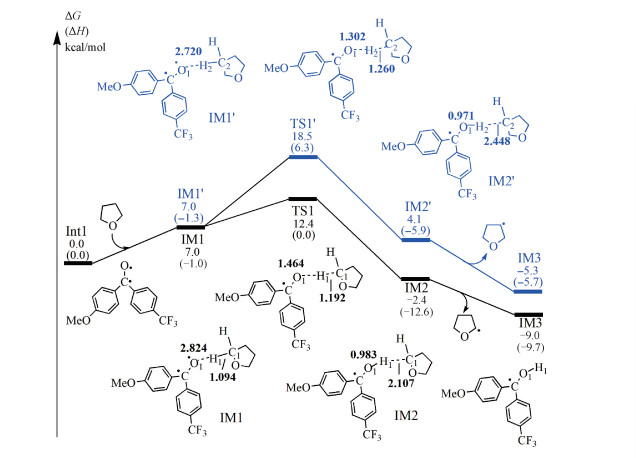
|
Download:
|
|
The values were calculated in the solvent of tetrahydrofuran (THF) at 298 K. All bond lengths are given in Å. Fig. 2 Free energy profiles along the pathways for the formation of the ortho- and meta-positioned THF· radicals induced by triplet excited ketone |
|
In order to determine the composition and structure of Ni catalysts, we optimized the structures of several nickel complexes, such as Ni(acac)2, Niacac, NiL2, and NiL (L=5, 5′-dimethyl-2, 2′-bipyridine). The calculated results show that these species all correspond to the minima in the potential energy surfaces and their electronic ground states are all in the triplet state. The calculated structures are shown in Fig.S1. For Ni(acac)2, as a nickel resource in the reaction system, its singlet state is energetically 23.4 kcal/mol higher than its triplet state (Table S2). Therefore, only the triplet Ni(acac)2 was considered to take part in the reaction processes. Furthermore, considering that the tetracoordinated Ni(acac)2 and NiL2 should be somewhat difficult to cooperate with reactants due to the steric hindrance, we turned our attention to the other two nickel species (Niacac and NiL). Niacac should be generated from the dissociation of Ni(acac)2, and thus the reaction free energy of the dissociation process was calculated. The value is predicted to be 13.2 kcal/mol, implying that this process is unfavorable thermodynamically. NiL should be formed from the ligand substitution between Ni(acac)2 and L. Our calculations indicate that the reaction free energy for this ligand-exchange reaction is -8.2 kcal/mol (Table S3), demonstrating that the process is feasible from a thermodynamic point of view. Therefore, the NiL species may play an important role in the followed sp3 C—H arylated product formation. Herein, we calculated the detailed mechanisms of reactions between aryl halide and THF· catalyzed respectively by NiL (1Cat) and Niacac (2Cat) in the triplet state to figure out the catalytic activities of both the Ni catalysts, although the formation of NiL has advantage over that of Niacac thermodynamically.
The formation of sp3 C—H arylated product catalyzed by 1Cat and 2Cat
The reaction pathways catalyzed by 1Cat and 2Cat were calculated, respectively, and the results are shown in Figs. 3 and S2. As can be seen in Fig. 3, there are two pathways (Path a and Path b) from the reactants to an intermediate 1-IM3 for the C—H arylated reaction catalyzed by 1Cat. Along Path a, 1Cat firstly cooperates with aryl halide, giving rise to a precomplex 1-IM1a, and the reaction free energy for this step is 1.0 kcal/mol. Then, the oxidative addition of aryl halide to the nickel center leads to a tetrahedron type Ni(Ⅱ) intermediate 1-IM2a via a transition state 1-TS1a. Although the free energy of 1-IM1a is 1.0 kcal/mol higher than that of the reactants, the followed reaction step (from 1-IM1a to 1-IM2a) releases the free energy of 52.1 kcal/mol, which could promote the reaction to proceed. It is noted that 1-TS1a has 1.1 kcal/mol lower in free energy than 1-IM1a, however, 1-TS1a is 1.7 kcal/mol higher than 1-IM1a in gas-phase, which might mean the interaction of solvent with this transition state is stronger than that with 1-IM1a. Therefore, the oxidative addition of aryl halide to 1Cat should take place quite easily both thermodynamically and kinetically. Subsequent coordination of THF· (generated in the triplet ketone catalysis discussed above) to Ni(Ⅱ) intermediate 1-IM2a has only a free energy barrier of 11.4 kcal/mol, leading to a Ni(Ⅲ) intermediate 1-IM3 with a free energy of -52.2 kcal/mol relative to the reactants. Therefore, Path a is feasible both kinetically and thermodynamically and should play an important role in the formation of arylated product. Along Path b (Fig. 3), the NiL firstly cooperates with THF· to form a T-shaped Ni(Ⅰ) intermediate 1-IM1b, with a large driving force (ΔG=-32.4 kcal/mol), and no free energy barriers exist in this step (Table S4), demonstrating that this reaction step is favorable both thermodynamically and kinetically. The subsequent oxidative addition of aryl halide to the nickel center of 1-IM1b occurs via a transition state 1-TS1b, leading to the same intermediate 1-IM3 as Path a. Although this reaction step undergoes a 24.6 kcal/mol free energy barrier, the free energy released in the previous step is enough to overcome this barrier. It seems that Path b should also play a role in the reaction. However, taking the reaction conditions[39] into consideration, we must mention that the amount of THF· should be far less than that of aryl halide. Therefore, the initial reaction could proceed along Path a, namely, the NiL first cooperates with the aryl halide rather than THF·. Thus, our further discussion will mainly focus on Path a.
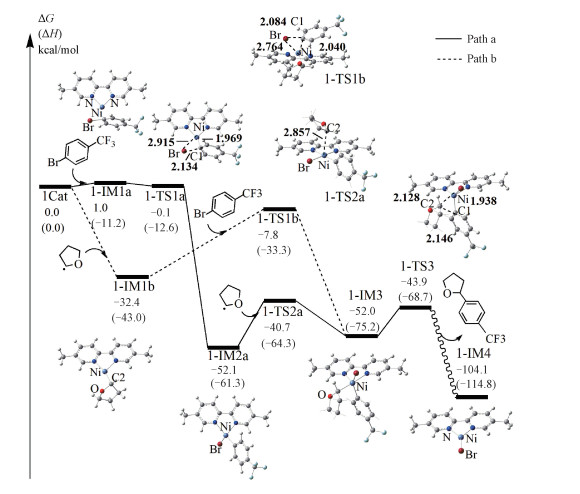
|
Download:
|
|
The values were calculated in the solvent of THF at 298 K. Enthalpies are shown in parentheses. All bond lengths are given in Å. Several H atoms have been omitted for clarity. Fig. 3 Free energy profiles for the reaction pathways of sp3 C—H arylation catalyzed by 1Cat |
|
The followed reaction from 1-IM3 is the reductive elimination, generating the targeted C—H arylation product and [BrNi(Ⅰ)L]0 intermediate 1-IM4 through a transition state 1-TS3 with a free energy barrier of 8.1 kcal/mol, and the reaction free energy for this step is predicted to be -52.1 kcal/mol, manifesting that this step occurs easily both kinetically and thermodynamically. In summary, the formation of the sp3 C—H arylated product catalyzed by 1Cat includes three reaction steps, namely, the oxidative addition of 1Cat and aryl bromide, the cooperation of THF· to Ni(Ⅱ) intermediate, and the reductive elimination of Ni(Ⅲ) to generate product, and the second one is the rate determined step. The overall free energy barrier (corresponding to the free energy barrier for the rate-limiting step) and overall reaction free energy are 11.4 and -104.1 kcal/mol, respectively, indicating that the 1Cat catalyzed C—H arylated reaction is favorable from both kinetic and thermodynamic points of view. It should be mentioned that the experiments were at room temperature and it is noted that the reaction at room temperature usually has a free energy barrier near 20 kcal/mol. However, our calculated free energy barriers are around 12 kcal/mol (see Figs. 2 and 3). The mismatch between them might derive from the several possible causes. The first one is that the formation of the active catalyst [1Cat (NiL)] might have higher free energy barriers, that is, the activation of the catalyst may require the room temperature condition. The second one is that the visible light induced reaction might also occur below room temperature. The third one may be that the free energy barrier is underestimated due to the computational method.
The reaction pathway for the 2Cat catalyzed C—H arylation is similar to that catalyzed by 1Cat (see Fig.S2). The overall free energy barrier and reaction free energy are calculated to be 21.8 and -105.7 kcal/mol, respectively, indicating that 2Cat also has catalytic activities for the sp3 C—H arylation. However, considering that the formation of 2Cat has disadvantage over that of 1Cat (see above), 1Cat should be the active catalyst for the sp3 C—H arylation. In addition, by comparing the reaction pathways catalyzed by 1Cat and 2Cat, it could also be found that the energy barriers for the three key procedures (the oxidative addition of nickel catalyst and aryl halide, the cooperation of THF· to the Ni(Ⅱ) intermediate, and the reductive elimination of Ni(Ⅲ) intermediate to release product) catalyzed by 1Cat (1.0, 11.4, 8.1 kcal/mol, Fig. 3) are lower than that by 2Cat (4.4, 21.8, 8.3 kcal/mol, Fig.S2). Therefore, 1Cat should play more important role in the reaction than 2Cat from a kinetic point of view.
In order to give the insight into catalytic activities of both 1Cat and 2Cat, we compare the charge distributions in the key structures along the reaction pathways catalyzed by 1Cat and 2Cat. The results can be seen in Table 1. It is evident that in the structure of 1Cat, the ligand L possesses stronger electron-absorbing property than acac, which contributes to the better electropositivity of nickel in 1Cat (0.594 e) than that in 2Cat (0.554 e). Furthermore, the 1Cat moiety (0.268 and 0.480 e) has more positive charges than the 2Cat moiety (0.136 and 0.107 e) in n-IM1 and n-TS1, showing more electrons move to the aryl halide reactant catalyzed by 1Cat than by 2Cat. Therefore, the oxidative addition of aryl halide to 1Cat is more favorable than to 2Cat. This may explain the higher energy barrier in the oxidative addition of the aryl halide with 2Cat than with 1Cat. For the cooperation of THF· to the Ni(Ⅱ) intermediate, because C(sp3) (the carbon center of THF·) and Ni center for both n-TS2s all have positive charges (0.100 and 0.095 e for C(sp3), 0.392 and 0.447 e for Ni center), C(sp3) might be more feasible to cooperate with less positive Ni center in 1-TS2, which is also consistent with the fact that the distance between the Ni and C2 atoms in 1-TS2 (2.857 Å) is much shorter than that in 2-TS2 (3.308 Å). Thus, the reaction step from n-IM2 to n-IM3 catalyzed by 1Cat has a lower energy barrier than that by 2Cat. To sum up, the calculated results indicate that both 1Cat and 2Cat have catalytic activities for C—H arylation reaction but the former is advantageous to be formed and more active than the latter, just explaining the experimental fact that the high yield (95%) of target sp3 C—H arylated product is achieved under the presence of the L (5, 5′-dimethyl-2, 2′-bipyridine) ligand, while that is lower (35%) under the absence of the L ligand[39].
|
|
Table 1 The charge distributions of the stationary points along the pathways of sp3 C—H arylated reactions catalyzed by 1Cat and 2Cat |
To achieve catalytic cycling, the regeneration of Ni catalysts is crucial. There are three possible pathways for the regeneration of the Ni catalyst. We performed calculations for them in detail and the results are shown in Figs. 4, S3 and Tables S5, S6. The first pathway includes three reaction steps (Fig. 4): the reaction of ketyl radical (IM3 in Fig. 2) with Na2CO3 producing the doublet ketone anion and [HNa2CO3]+ cation (Step 1), the single electron transfer (SET) from the doublet ketone anion to 1-IM4 ([BrNi(Ⅰ)L]0) generating the singlet ketone (the ground state) and the [BrNi(Ⅰ)L]- anion (Step 2), and the reaction of [BrNi(Ⅰ)L]- anion and [HNa2CO3]+ cation releasing the 1Cat (Step 3). It is noted that Step 1 is the acid-base reaction, while Step 3 is the reaction between positive and negative ions. Both reactions should occur easily. The free energy barrier of Step 2 was calculated based on Marcus theory[52-54], and the value is predicted to be 11.1 kcal/mol (Table S5), demonstrating that the process is favorable kinetically. The overall reaction free energy for the regeneration of 1Cat is predicted to be -23.0 kcal/mol. Therefore, the first pathway should be feasible from both kinetic and thermodynamic points of view. It is worth mentioning that Na2CO3 is a key species in this pathway.
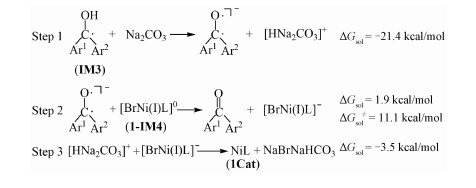
|
Download:
|
|
Fig. 4 Three reaction processes for regeneration of nickel catalyst (NiL) |
|
The second pathway for the regeneration of the Ni catalyst is the reaction of ketyl radical with [BrNi(Ⅰ)L]0, which was speculated by Martin group[39]. In order to figure out its feasibility, we investigated this pathway in detail and the results are shown in Table S6. Firstly, the reaction of [BrNi(Ⅰ)L]0 with ketyl radical leads to the formation of triplet [HBrNiL]0 and singlet ketone, and the reaction free energy is -2.5 kcal/mol. Then the triplet [HBrNiL]0 dissociates into the triplet NiL and HBr, and the calculated reaction free energy of this process is 48.5 kcal/mol. Obviously, this process is unfavorable thermodynamically. However, the produced HBr can easily react with Na2CO3 existed in the reaction system, releasing the free energy of 46.8 kcal/mol, which could promote the regeneration of 1Cat. Our results support the speculation by Shen et al.[39] on the one hand, and clearly illustrate the importance of Na2CO3 in the regeneration of the Ni catalyst on the other hand.
The third possible pathway is that the ketyl radical may abstract the Br radical in the Ni(Ⅲ) intermediate 1-IM3 to realize the regeneration of 1Cat. Unfortunately, the free energy barrier has at least 34.4 kcal/mol with respect to 1-IM3 plus the ketyl radical (Fig.S3). This might be a hint that the ketyl radical abstracting Br radical is impossible.
To sum up, our calculations indicate that there are two reaction pathways for the regeneration of the NiL catalyst in the reaction system, and the Na2CO3 species plays a key role in both the pathways. The calculated results give a perfect explanation of the experimental facts that the yield of sp3 C—H arylated product is only 5% under the absence of Na2CO3[39].
2.2 Substituent effect of aryl halides on the sp3 C—H arylationIn order to figure out the substituent effect of aryl halide on sp3 C—H arylation, the reaction mechanisms between THF and reactant 1 (see Fig. 1) with the different properties catalyzed by 1Cat (reactions A1.2-A3 in Table 2) were investigated in detail and the relative free energies of all the stationary points to the corresponding reactants along the reaction pathways are shown in Table 2. For the sake of convenience, reaction A1.1 and the experimental yields of target products are also shown in Table 2. It should be noted that reactant 1 in reactions A1.2 and A1.4 was designed by us for later discussion. Considering that these reactions all require THF (the formation of THF was discussed in 3.1.1), herein, we mainly focus on the nickel catalysis (Process 2 in Fig. 1).
It should be mentioned that the free energy barriers for the eleven reactions are different (see Table 2). To shed light on the better performance of the reactants bearing the electron-withdrawing substituents rather than the electron-donating substituents, we mainly compare the free energy barriers along the potential energy surface for reactions A1.1-A1.3 and A16.-A1.8 with the para-positioned substituents in aryl bromides. The former four reactions contain the electron-withdrawing substituents, while the latter two reactions have electron-donating substituents. In the first oxidative addition, it can be found that for those reactants possessing electron-withdrawing substituents (A1.1, A1.2, A1.3, A1.6), the free energies of 1-TS1a are all lower than that of 1-IM1a, indicating that these 1-TS1as may disappear in the reaction path calculations of the higher-level theory. Therefore, the cooperation of these aryl bromides with 1Cat may proceed without any free energy barriers. On the contrary, for those reactants with electron-donating substituents (A1.7, A1.8), the free energies of 1-TS1a are higher than that of 1-IM1a, being 2.0 and 2.7 kcal/mol, respectively. Then in the following oxidative addition of THF, the electron-withdrawing group owners (A1.1, A1.2, A1.3, A1.6) undergo somewhat lower free energy barriers (11.4, 15.9, 18.6, and 13.9 kcal/mol, respectively) than the electron-donating group owners (20.1 and 20.0 kcal/mol in A1.7, A1.8 separately). The tendency in the reductive elimination is similar to that in the coordination of Ni(Ⅱ) intermediate with THF. In summary, there is an overwhelming preference for electron-withdrawing substituents over electron-donating substituents, which explains that the yields of the former are higher than that of the latter experimentally. Moreover, it is worth mentioning that the —CN group in reactant 1 (reaction A1.6) is thermodynamically more favorable to cooperate with nickel center than the C1—Br bond (Fig.S4). This fact may be the reason that reaction A1.6 has lower yields than reactions A1.1 and A1.3.
To unveil the effect of the substituent position in aryl halide on the reaction, we designed the meta-positioned ester group of aryl halide (reaction A1.4 in Table 2). It can be found from Table 2 that reactions A1.4 and A1.5 (ortho-positioned ester group of aryl halide) also have lower free energy barriers, similar to the case of para-positioned one (A1.3). These facts indicate that the substituent position has less effect on the reaction. In other words, the yield of the C—H aryl product might be satisfactory if aryl halides with the meta-positioned ester group is taken as reactant 1.
|
|
Table 2 The relative free energies of the stationary points along the pathways of sp3 C—H arylated reactions between THF and reactant 1 with various substituents in THF solvent |
As shown in Table 2, reactions A2.1 and A2.2 with heteroaryl bromide reactants and reaction A3 with vinyl bromide reactants all have similar reaction pathways to Path a in reaction A1.1. Also, the three reactions all have low free energy barriers, which demonstrates that they are feasible for the sp3 C—H arylation reactions. Based on our calculations, the overall free energy barriers for all the eleven reactions are smaller than 20.1 kcal/mol, and the reaction free energies are between -102.1 and -105.8 kcal/mol. Therefore, all the reactions should occur from both kinetic and thermodynamic points of view. The calculation results are consistent with experiment[39].
2.3 Mechanisms for sp3 C—H alkylation reactionsFor the sp3 C—H alkylation, we selected reaction B1 (see Fig. 1(b)) as an example and calculated its detailed mechanism. Since the formation of Niacac is unfavorable (see above), the NiL′ (L′ = 4, 4′-diterbutyl-2, 2′-bipyridine) was used as the catalyst (named as 3Cat). Considering the formation of THF is the same as that of the sp3 C—H arylation reactions (discussed in 3.1.1), herein, we mainly focus on the 3Cat catalyzed reaction processes for alkylation reactions. The computed free energy profile for the NiL′ catalyzed sp3 C—H alkylation reaction is shown in Fig. 5.
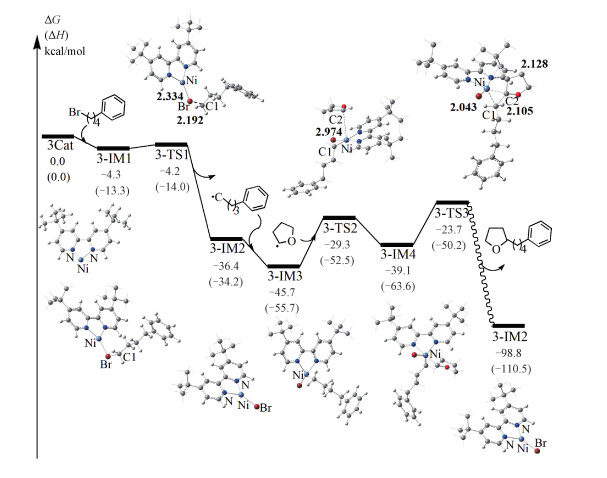
|
Download:
|
|
Enthalpies are given in parentheses. The values were calculated in the solvent of THF at 298 K. Bond lengths are given in Å. Several H atoms have been omitted for clarity. Fig. 5 Free energy profiles for the sp3 C—H alkylation reaction |
|
As shown in Fig. 5, notably, unlike the direct oxidative addition of aryl bromide to the NiL to afford Ni(Ⅱ) intermediate in the sp3 C—H arylation, here in the alkylation pathway, the generation of Ni(Ⅱ) complex requires two steps. First, starting from 3-IM1, the cleavage of the C1—Br bond via a transition state 3-TS1 generates Ni(Ⅰ) intermediate 3-IM2 and phenylbutyl radical. This process only requires a low free energy barrier (0.1 kcal/mol) and the reaction free energy is -36.4 kcal/mol, which means it is kinetically and thermodynamically accessible. Then the phenylbutyl radical coordinates with the Ni(Ⅰ) intermediate to form the tetrahedron type Ni(Ⅱ) complex 3-IM3, with a reaction free energy of -9.3 kcal/mol. Subsequently, the carbon centered radical THF adds to the 3-IM3 via a free energy barrier of 16.4 kcal/mol, giving rise to the Ni(Ⅲ) intermediate 3-IM4, and the reaction free energy of this step is 6.6 kcal/mol. Then the reductive elimination occurs via a transition state 3-TS3, which requires a free energy barrier of 15.4 kcal/mol, producing an sp3 C—H alkylated product and releasing a free energy of 59.7 kcal/mol. Similar to the case of 1Cat, the regeneration of 3Cat also includes three steps (see Fig.S5), and should be favorable thermodynamically and kinetically. We will not discuss it in detail here.
The reaction pathways of the alkyl halide with the cyclopentane and with cyclohexane catalyzed by 3Cat (NiL′), named as reactions B2 and B3, respectively, were also investigated. Since one reactant (alkyl halide) of these two reactions are the same as reaction B1, only the ketone catalyzed HAT process and the Ni(Ⅱ)→Ni(Ⅲ)→Ni(Ⅰ) transformation in the nickel catalysis (namely, the cooperation of carbon centered radical with Ni(Ⅱ) intermediate, and the eliminated reduction of Ni(Ⅲ) intermediate to release Ni(Ⅰ) intermediate) need to be explored. The calculated results are given in Fig.S6. It can be found from Fig.S6(a) that, in the ketone catalysis, the generations of cyclopentane radical and cyclohexane radical require the free energy barriers of 15.0 and 14.3 kcal/mol, respectively. Although their free energy barriers are 2.6 and 1.9 kcal/mol higher than that of the THF radical, they could also occur. Thus, we speculate that both cyclopentane and cyclohexane may be suitable for the sp3 C—H arylation reactions. As for the nickel catalysis, it is noted that the two free energy barriers in the Ni(Ⅱ)→Ni(Ⅲ)→Ni(Ⅰ) transformation for reaction B2 (B3) are 22.2 (20.7) and 16.3 (15.1) kcal/mol, respectively. These two energy barriers are higher than or similar to those of reaction B1, respectively, as shown in Fig.S6(b). These results indicate that reactions B2 and B3 are less favorable than reaction B1 in the kinetic point of view, which is consistent with the experimental results (the yield of the former two are 41% and 51%, respectively, and the latter is 86%)[39].
In addition, comparing the reaction pathways of both the C—H alkylation and arylation, we could speculate that the lower yield of the former may also result from the higher free energy barriers in the ketone catalysis and Ni (Ⅱ)→Ni(Ⅲ)→Ni(Ⅰ) transformation processes in the nickel catalysis.
3 ConclusionFocusing on the reactions of metallaphotoredox catalyzed sp3 C—H arylation and alkylation, we performed density function theory calculations for the detailed mechanisms of THF reacting with aryl halides bearing different substituents and alkyl halide and the whole mechanisms are shown in Fig. 6. For the sp3 C—H arylation, the calculations support that the whole reaction consists of the three reaction processes: the formation of THF radical (ketone catalysis), generation of the product catalyzed by nickel catalysts (nickel catalysis), and regeneration of the Ni catalyst, just as the experimental researchers speculated. The THF radical could be produced by the triplet ketone extracting the H atom of THF with a free energy barrier of 12.4 kcal/mol. In the nickel catalysis, NiL (L=5, 5′-dimethyl-2, 2′-bipyridine), not Niacac, is predicted to be the active catalyst, and there exist two reaction pathways. One is the cooperation of aryl halide with nickel center firstly, the other is that nickel center firstly combines with THF radical. The former should play a more important role in the reaction. Those reactions for aryl halides containing electron-donating groups have higher free energy barriers than those containing electron-withdrawing groups, but the latter reactions are also feasible kinetically. For the regeneration of the nickel catalyst, there are two potential reaction pathways and the Na2CO3 species should play a key role in both the pathways based on our calculations, which gives a perfect explanation of the experimental facts that the yield of sp3 C—H arylated product is only 5% under the absence of Na2CO3.
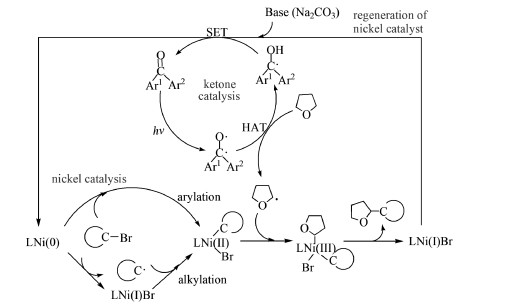
|
Download:
|
|
Fig. 6 Predicted reaction mechanisms for the sp3 C—H functionalization |
|
For the sp3 C—H alkylation, the reaction mechanisms of THF, cyclopentane, and cyclohexane with alky halide were investigated. Our calculations demonstrate that the three reactions have similar mechanisms to the arylation reactions. The formation of the cyclopentane and cyclohexane radicals have only 2.6 and 1.9 kcal/mol higher free energy barriers than that of the THF radical, and both cyclopentane and cyclohexane may be suitable for the sp3 C—H arylations. We expect that the present work could provide important information for experimental workers to design the sp3 C—H functionalized reaction system.
Appendix|
|
Table S1 Bond lengths of C—H in tetrahydrofuran (THF) |
|
|
Table S2 Free energies for Ni(acac)2 and NiL of singlet and triplet states |
|
|
Table S3 Free energies in the transformation of nickel catalyst |
|
|
Table S4 Changes of total energies following the shortening Ni—C bond |
Comments: As shown in Table S4, the total energy decreases monotonically along with the shortening distances between Ni and C from 4.381 Å to 1.981 Å. Thus, we speculate that the cooperation of THF· with 1 Cat is easy to proceed and there is no free energy barrier along the reaction pathway.
|
|
Table S5 The calculated values for Step 2 in the regeneration of Ni catalysts using the Marcus theory |
Comments: The free energy barriers for single electron transfer (SET) from the doublet ketone anion to [BrNi(Ⅰ)L]0 or [BrNi(Ⅰ)L′]0, generating the ground state diaryl ketone and the [BrNi(Ⅰ)L]- or [BrNi(Ⅰ)L′]- anion, were calculated based on the Marcus Theory. The energy barriers were obtained by
| $ \Delta {G^ \ne }\frac{{{{(\lambda {\rm{ }} + \Delta G)}^2}}}{{4\lambda }}. $ | (A1) |
In (A1), ΔG is the Gibbs free energy of the SET reaction, λ is the reorganization energy, including two components: λN is the nuclear reorganization and λS is the solvent reorganization. The energies of both the nuclear reorganization and the solvent reorganization were calculated referring to the published scheme by the Maseras group.
|
|
Table S6 Reaction Gibbs free energies of the second pathway for the regeneration of the Ni catalyst |
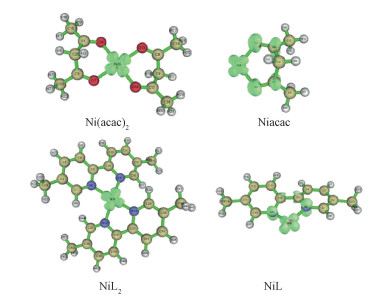
|
Download:
|
|
Drawn by Multiwfn[A1]. Spin densities are shown as the green balls. Fig. S1 The structures of four possible triplet nickel catalysts for sp3 C—H arylation reactions |
|
|
|
Table S7 The key bond lengths of 1-IM1as |
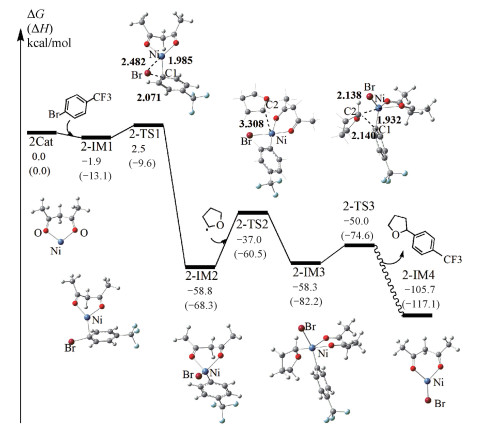
|
Download:
|
|
Fig. S2 Free energy profiles for the reaction pathways of arylation catalyzed by 2Cat |
|
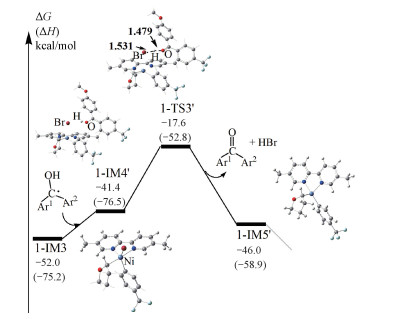
|
Download:
|
|
Fig. S3 Free energy profiles along the pathway for the regeneration of nickel catalyst |
|
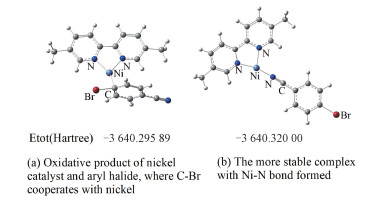
|
Download:
|
|
Fig. S4 Structures of the complexes of nickel catalyst and aryl halide for reaction A1.6 |
|
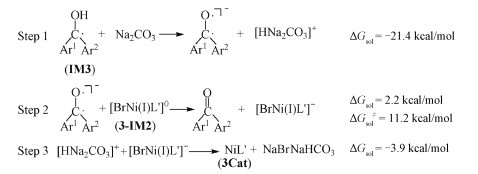
|
Download:
|
|
Fig. S5 Three steps for the regeneration of NiL′ (3Cat) |
|

|
Download:
|
|
Fig. S6 Free energy profiles for alkylations of cyclopentane and cyclohexane |
|
[A1] Lu T, Chen F. Multiwfn: a multifunctional wavefunction analyzer[J]. J Comput Chem, 2012, 33(5): 580-592. DOI: 10.1002/jcc.22885.
| [1] |
Ackermann L, Vicente R. Ruthenium-catalyzed direct arylations through C-H bond cleavages[J]. Topics in Current Chemistry, 2010, 292: 211-229. DOI:10.1007/128_2009_9 |
| [2] |
Bouffard J, Itami K. Rhodium-catalyzed C-H bond arylation of arenes[J]. Topics in Current Chemistry, 2010, 292: 231-280. DOI:10.1007/128_2009_12 |
| [3] |
Tong X F, Zhang Z G, Zhang X M. Rhodium-catalyzed cycloisomerization of 1, 6-enynes with an intramolecular halogen shift[J]. Journal of Graduate University of Chinese Academy of Sciences, 2006, 23(3): 416-426. DOI:10.7523/j.issn.2095-6134.2006.3.022 |
| [4] |
Tao Y, Dang Y F, Wang Z X. Studies on Rh (Ⅲ)-catalyzed[J]. Journal of University of Chinese Academy of Sciences, 2016, 33(1): 57-64. DOI:10.7523/j.issn.2095-6134.2016.01.009 |
| [5] |
Beck E M, Gaunt M J. Pd-catalyzed C-H bond functionalization on the indole and pyrrole nucleus[J]. Topics in Current Chemistry, 2010, 292: 85-121. DOI:10.1007/128_2009_15 |
| [6] |
Daugulis O. Palladium and copper catalysis in regioselective, intermolecular coupling of C-H and C-Hal bonds[J]. Topics in Current Chemistry, 2010, 292: 57-84. DOI:10.1007/128_2009_10 |
| [7] |
Sun C L, Li B J, Shi Z J. Direct C-H transformation via iron catalysis[J]. Chemical Reviews, 2011, 111(3): 1293-1314. DOI:10.1021/cr100198w |
| [8] |
Aihara Y, Chatani N. Nickel-catalyzed direct alkylation of C-H bonds in benzamides and acrylamides with functionalized alkyl halides via bidentate-chelation assistance[J]. Journal of the American Chemical Society, 2013, 135(14): 5308-5311. DOI:10.1021/ja401344e |
| [9] |
Muto K, Yamaguchi J, Itami K. Nickel-catalyzed C-H/C-O coupling of azoles with phenol derivatives[J]. Journal of the American Chemical Society, 2012, 134(1): 169-172. DOI:10.1021/ja210249h |
| [10] |
Nakao Y, Yamada Y, Kashihara N, et al. Selective C-4 alkylation of pyridine by nickel/Lewis acid catalysis[J]. Journal of the American Chemical Society, 2010, 132(39): 13666-13668. DOI:10.1021/ja106514b |
| [11] |
Daugulis O, Do H Q, Shabashov D. Palladium-and copper-catalyzed arylation of carbon-hydrogen bonds[J]. Accounts of Chemical Research, 2009, 42(8): 1074-1086. DOI:10.1021/ar9000058 |
| [12] |
Mkhalid I A I, Barnard J H, Marder T B, et al. C-H activation for the construction of C-B bonds[J]. Chemical Reviews, 2010, 110(2): 890-931. DOI:10.1021/cr900206p |
| [13] |
Dewanji A, Krach P E, Rueping M. The dual role of benzophenone in visible-light/nickel photoredox-catalyzed C-H arylations: hydrogen-atom transfer and energy transfer[J]. Angewandte Chemie International Edition, 2019, 131(11): 3604-3608. DOI:10.1002/anie.201901327 |
| [14] |
Lyons T W, Sanford M S. Palladium-catalyzed ligand-directed C-H functionalization reactions[J]. Chemical Reviews, 2010, 110(2): 1147-1169. DOI:10.1021/cr900184e |
| [15] |
Graetzel M. Artificial photosynthesis: water cleavageinto hydrogen and oxygen by visible light[J]. Accounts of Chemical Research, 1981, 14(12): 376-384. DOI:10.1021/ar00072a003 |
| [16] |
Meyer T J. Chemical approaches to artificial photosynthesis[J]. Accounts of Chemical Research, 1989, 22(5): 163-170. DOI:10.1021/ar00161a001 |
| [17] |
Takeda H, Ishitani O. Development of efficient photocatalytic systems for CO2 reduction using mononuclear and multinuclear metal complexes based on mechanistic studies[J]. Coordination Chemistry Reviews, 2010, 254(3/4): 346-354. DOI:10.1016/j.ccr.2009.09.030 |
| [18] |
Kalyanasundaram K, Grätzel M. Applications of functionalized transition metal complexes in photonic and optoelectronic devices[J]. Coordination Chemistry Reviews, 1998, 177(1): 347-414. DOI:10.1016/S0010-8545(98)00189-1 |
| [19] |
Shaw M H, Twilton J, MacMillan D W C. Photoredox catalysis in organic chemistry[J]. The Journal of Organic Chemistry, 2016, 81(16): 6898-6926. DOI:10.1021/acs.joc.6b01449 |
| [20] |
Liu L Q, Yang J K. Syntheses of 1, 3-bis (aryl butadienyl ketone) propane derivatives and their visible light photocatalytic[4+4] and[2+2] cycloadditions[J]. Journal of Graduate University of Chinese Academy of Sciences, 2012, 29(2): 180-191. DOI:10.7523/j.issn.2095-6134.2012.2.006 |
| [21] |
Osawa M, Nagai H, Akita M. Photo-activation of Pd-catalyzed Sonogashira coupling using a Ru/bipyridine complex as energy transfer agent[J]. Dalton Transactions, 2007(8): 827-829. DOI:10.1039/b618007h |
| [22] |
Kalyani D, McMurtrey K B, Neufeldt S R, et al. Room-temperature C-H arylation: merger of Pd-catalyzed C-H functionalization and visible-light photocatalysis[J]. Journal of the American Chemical Society, 2011, 133(46): 18566-18569. DOI:10.1021/ja208068w |
| [23] |
Neufeldt S R, Sanford M S. Combining transition metal catalysis with radical chemistry: dramatic acceleration of palladium-catalyzed C-H arylation with diaryliodonium salts[J]. Advanced Synthesis & Catalysis, 2012, 354(18): 3517-3522. DOI:10.1002/adsc.201200738 |
| [24] |
Xuan J, Zeng T T, Feng Z J, et al. Redox-neutral α-allylation of amines by combining palladium catalysis and visible-light photoredox catalysis[J]. Angewandte Chemie International Edition, 2015, 54(5): 1625-1628. DOI:10.1002/anie.201409999 |
| [25] |
Czyz M L, Lupton D W, Polyzos A. Auxiliary-directed C (sp3)-H arylation by synergistic photoredox and palladium catalysis[J]. Chemistry: A European Journal, 2017, 23(58): 14450-14453. DOI:10.1002/chem.201704045 |
| [26] |
Gandeepan P, Muller T, Zell D, et al. 3d transition metals for C-H activation[J]. Chemical Reviews, 2019, 119(4): 2192-2452. DOI:10.1021/acs.chemrev.8b00507 |
| [27] |
Tasker S Z, Standley E A, Jamison T F. Recent advances in homogeneous nickel catalysis[J]. Nature, 2014, 509(7500): 299-309. DOI:10.1038/nature13274 |
| [28] |
Aihara Y, Wuelbern J, Chatani N. The nickel (Ⅱ)-catalyzed direct benzylation, allylation, alkylation, and methylation of C-H bonds in aromatic amides containing an 8-aminoquinoline moiety as the directing group[J]. Bulletin of the Chemical Society of Japan, 2015, 88(3): 438-446. DOI:10.1246/bcsj.20140387 |
| [29] |
Castro L C M, Chatani N. Nickel catalysts/N, N'-bidentate directing groups: an excellent partnership in directed C-H activation reactions[J]. Chemistry Letters, 2015, 44(4): 410-421. DOI:10.1246/cl.150024 |
| [30] |
Cai X H, Xie B. Recent advances on nickel-catalyzed C-H bonds functionalized reactions[J]. Arkivoc, 2015(ⅰ): 184-211. DOI:10.3998/ark.5550190.p008.915 |
| [31] |
Yamaguchi J, Muto K, Itami K. Recent progress in nickel-catalyzed biaryl coupling[J]. European Journal of Organic Chemistry, 2013, 2013(1): 19-30. DOI:10.1002/ejoc.201200914 |
| [32] |
Le C, Liang Y F, Evans R W, et al. Selective sp3 C-H alkylation via polarity-match-based cross-coupling[J]. Nature, 2017, 547(7661): 79-83. DOI:10.1038/nature22813 |
| [33] |
Shaw M H, Shurtleff V W, Terrett J A, et al. Native functionality in triple catalytic cross-coupling: sp3 C-H bonds as latent nucleophiles[J]. Science, 2016, 352(6291): 1304-1308. DOI:10.1126/science.aaf6635 |
| [34] |
Twilton J, Christensen M, DiRocco D A, et al. Selective hydrogen atom abstraction through induced bond polarization: direct α-arylation of alcohols through photoredox, HAT, and nickel catalysis[J]. Angewandte Chemie International Edition, 2018, 57(19): 5369-5373. DOI:10.1002/anie.201800749 |
| [35] |
Zhang L M, Si X J, Yang Y Y, et al. The combination of benzaldehyde and nickel-catalyzed photoredox C (sp3)-H alkylation/arylation[J]. Angewandte Chemie International Edition, 2019, 58(6): 1823-1827. DOI:10.1002/anie.201810526 |
| [36] |
Fan X Z, Rong J W, Wu H L, et al. Eosin Y as a direct hydrogen-atom transfer photocatalyst for the functionalization of C-H bonds[J]. Angewandte Chemie International Edition, 2018, 57(28): 8514-8518. DOI:10.1002/anie.201803220 |
| [37] |
Arceo E, Montroni E, Melchiorre P. Photo-organocatalysis of atom-transfer radical additions to alkenes[J]. Angewandte Chemie International Edition, 2014, 53(45): 12064-12068. DOI:10.1002/anie.201406450 |
| [38] |
Buonaugurio A, Zhang X X, Stokes S T, et al. The photoelectron spectrum of the benzaldehyde anion[J]. International Journal of Mass Spectrometry, 2015, 377: 278-280. DOI:10.1016/j.ijms.2014.05.006 |
| [39] |
Shen Y Y, Gu Y T, Martin R. sp3 C-H arylation and alkylation enabled by the synergy of triplet excited ketones and nickel catalysts[J]. Journal of the American Chemical Society, 2018, 140(38): 12200-12209. DOI:10.1021/jacs.8b07405 |
| [40] |
Frisch M J, Trucks G W, Schlegel H B, et al. Gaussian 09, Revision D. 01[CP]. Gaussian Inc, Wallingford CT, 2013.
|
| [41] |
Lee C, Yang W T, Parr R G. Development of the Colle-Salvetti correlation-energy formula into a functional of the electron density[J]. Physical Review B, Condensed Matter, 1988, 37(2): 785-789. DOI:10.1103/physrevb.37.785 |
| [42] |
Becke A D. Density-functional thermochemistry. Ⅲ. The role of exact exchange[J]. The Journal of Chemical Physics, 1993, 98(7): 5648-5652. DOI: 10.1063/1.464913.
|
| [43] |
Dolg M, Wedig U, Stoll H, et al. Energy-adjusted ab initio pseudopotentials for the first row transition elements[J]. The Journal of Chemical Physics, 1987, 86(2): 866-872. DOI:10.1063/1.452288 |
| [44] |
Hariharan P C, Pople J A. The influence of polarization functions on molecular orbital hydrogenation energies[J]. Theoretica Chimica Acta, 1973, 28(3): 213-222. DOI:10.1007/BF00533485 |
| [45] |
Fukui K. The path of chemical reactions-the IRC approach[J]. Accounts of Chemical Research, 1981, 14(12): 363-368. DOI:10.1021/ar00072a001 |
| [46] |
Hratchian H P, Schlegel H B. Accurate reaction paths using a Hessian based predictor-corrector integrator[J]. The Journal of Chemical Physics, 2004, 120(21): 9918-9924. DOI:10.1063/1.1724823 |
| [47] |
Hratchian H P, Schlegel H B. Using hessian updating to increase the efficiency of a hessian based predictor-corrector reaction path following method[J]. Journal of Chemical Theory and Computation, 2005, 1(1): 61-69. DOI:10.1021/ct0499783 |
| [48] |
Frisch M J, Pople J A, Binkley J S. Self-consistent molecular orbital methods 25. Supplementary functions for Gaussian basis sets[J]. The Journal of Chemical Physics, 1984, 80(7): 3265-3269. DOI:10.1063/1.447079 |
| [49] |
Zhao Y, Schultz N E, Truhlar D G. Design of density functionals by combining the method of constraint satisfaction with parametrization for thermochemistry, thermochemical kinetics, and noncovalent interactions[J]. Journal of Chemical Theory and Computation, 2006, 2(2): 364-382. DOI:10.1021/ct0502763 |
| [50] |
Marenich A V, Cramer C J, Truhlar D G. Universal solvation model based on solute electron density and on a continuum model of the solvent defined by the bulk dielectric constant and atomic surface tensions[J]. The Journal of Physical Chemistry B, 2009, 113(18): 6378-6396. DOI:10.1021/jp810292n |
| [51] |
Marenich A V, Cramer C J, Truhlar D G. Performance of SM6, SM8, and SMD on the SAMPL1 test set for the prediction of small-molecule solvation free energies[J]. The Journal of Physical Chemistry B, 2009, 113(14): 4538-4543. DOI:10.1021/jp809094y |
| [52] |
Fernández-Alvarez V M, Nappi M, Melchiorre P, et al. Computational study with DFT and kinetic models on the mechanism of photoinitiated aromatic perfluoroalkylations[J]. Organic Letters, 2015, 17(11): 2676-2679. DOI:10.1021/acs.orglett.5b01069 |
| [53] |
Fernández-Alvarez V M, Maseras F. Computational characterization of the mechanism for the light-driven catalytic trichloromethylation of acylpyridines[J]. Organic & Biomolecular Chemistry, 2017, 15(40): 8641-8647. DOI:10.1039/c7ob01826f |
| [54] |
Fernández-Alvarez V M, Ho S K Y, Britovsek G J P, et al. A DFT-based mechanistic proposal for the light-driven insertion of dioxygen into Pt (Ⅱ)-C bonds[J]. Chemical Science, 2018, 9(22): 5039-5046. DOI:10.1039/c8sc01161c |
 2022, Vol. 39
2022, Vol. 39 














